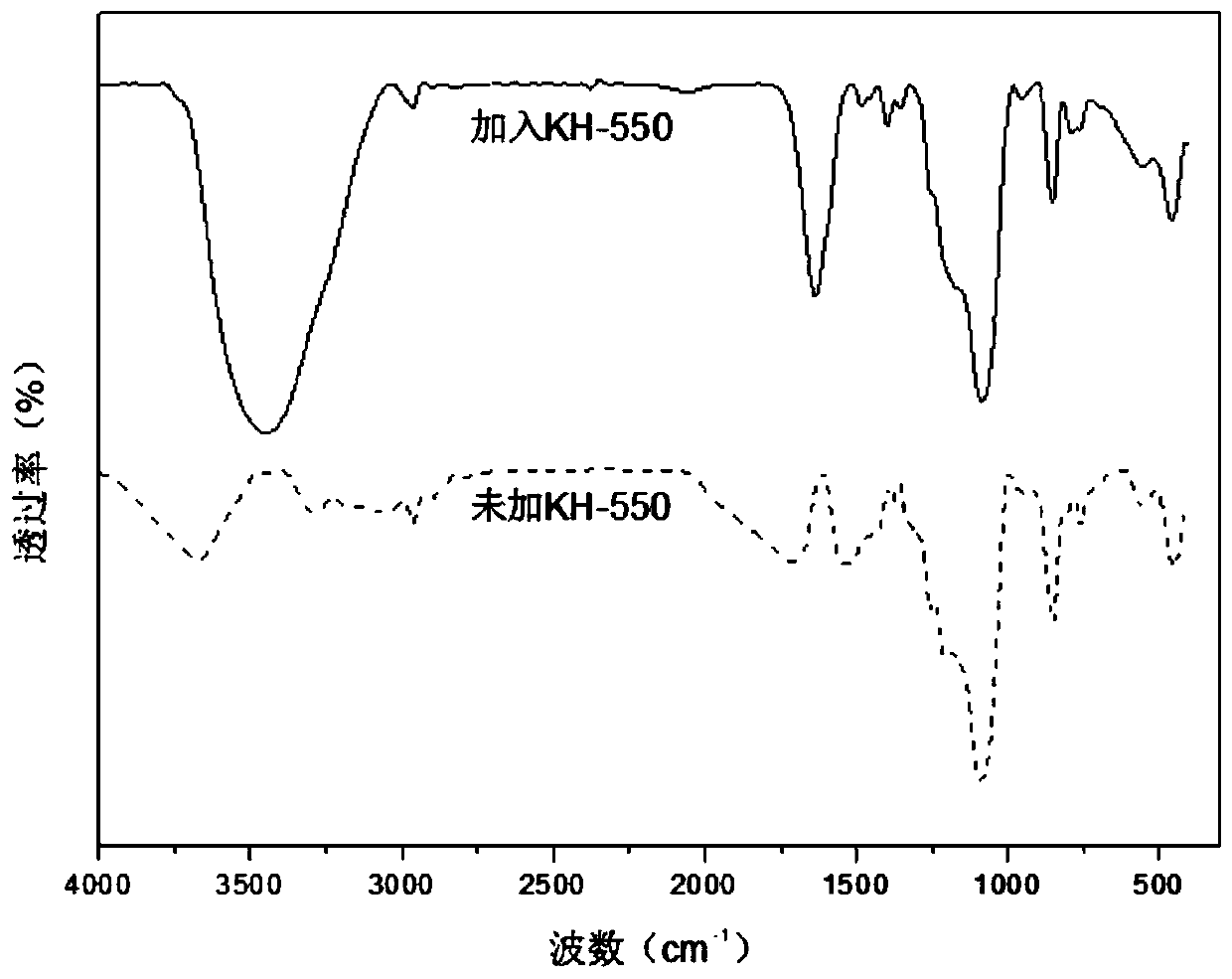Normal-pressure preparation method of high specific surface area intensive-hydrophobicity graphene oxide/silica composite aerogel
A high specific surface area, composite aerogel technology, applied in the direction of chemical instruments and methods, carbon compounds, silicon compounds, etc., can solve the problems of restricting the application of freeze-drying method, affecting the polycondensation process of precursors, and high airgel density. Achieve the effects of improving uneven pore size, shortening gel time, and high specific surface area
- Summary
- Abstract
- Description
- Claims
- Application Information
AI Technical Summary
Problems solved by technology
Method used
Image
Examples
Embodiment 1
[0053] Mix ethyl orthosilicate, ethanol, and water at a molar ratio of 1:7:2, stir at room temperature for 20 minutes, add dilute hydrochloric acid to the mixture until pH = 2, and react at room temperature for 8 hours. Add DMF dropwise to the mixture, wherein the mass ratio of DMF to ethyl orthosilicate is 0.15:1, after stirring for 30 minutes, add the ethanol solution of aminopropyltriethoxysilane dropwise to pH = 6, and add to the mixture 0.018g of graphene oxide hydrosol with a mass fraction of 5% was added dropwise, ultrasonicated at 50W for 30min at a temperature of 20°C, and the ethanol solution of aminopropyltriethoxysilane was continued to be added dropwise to the mixed solution to pH =7.2, placed in an ultrasonic cleaner for 8 minutes to form a gel.
[0054] The formed alcohol gel was aged at room temperature for 12 hours, then aged for 24 hours with 20% water / ethanol mixed solution and 20% tetraethyl orthosilicate / ethanol mixed solution with a volume fraction of 100...
Embodiment 2
[0057] Mix ethyl orthosilicate, ethanol, and water at a molar ratio of 1:14:2, stir at room temperature for 25 minutes, add dilute hydrochloric acid to the mixture until pH=2.5, and react at room temperature for 16 hours. Add DMF dropwise to the mixed solution and stir for 30 minutes, wherein the mass ratio of DMF to ethyl orthosilicate is 0.2:1, add the ethanol solution of aminopropyltriethoxysilane dropwise to pH = 6, and add to the mixed solution Add dropwise 0.18g of graphene oxide hydrosol with a mass fraction of 15%, ultrasonicate for 30min at 25°C at a power of 60W, and continue to add the ethanol solution of aminopropyltriethoxysilane dropwise to the mixed solution until pH = 7.5, after 12 minutes in an ultrasonic cleaner, a gel is formed.
[0058] The formed alcohol gel was aged at room temperature for 18 hours, and then aged with 15% water / ethanol mixed solution and 15% tetraethyl orthosilicate / ethanol mixed solution for 36 hours respectively, and respectively with a...
Embodiment 3
[0063] Mix ethyl orthosilicate, ethanol, and water at a molar ratio of 1:14:3, stir at room temperature for 30 minutes, add dilute hydrochloric acid to the mixture until pH=3, and react at room temperature for 24 hours. Add DMF dropwise to the mixture and stir for 30 minutes, wherein the mass ratio of DMF to ethyl orthosilicate is 0.25:1, add the ethanol solution of aminopropyltriethoxysilane drop by drop to pH = 6, and add to the mixture Add dropwise 0.27g of graphene oxide hydrosol with a mass fraction of 20%, ultrasonicate for 30min at 30°C at a power of 80W, and continue to dropwise add an ethanol solution of aminopropyltriethoxysilane to the mixture until pH=8 , placed in an ultrasonic cleaner for 18 minutes to form a gel.
[0064] The formed alcohol gel was aged at room temperature for 24 hours, and then aged for 18 hours with a water / ethanol mixture with a volume fraction of 25% and a tetraethyl silicate / ethanol mixture with a volume fraction of 30%, respectively. 100%...
PUM
| Property | Measurement | Unit |
|---|---|---|
| Specific surface area | aaaaa | aaaaa |
| Density | aaaaa | aaaaa |
| Thermal conductivity | aaaaa | aaaaa |
Abstract
Description
Claims
Application Information
 Login to View More
Login to View More - R&D
- Intellectual Property
- Life Sciences
- Materials
- Tech Scout
- Unparalleled Data Quality
- Higher Quality Content
- 60% Fewer Hallucinations
Browse by: Latest US Patents, China's latest patents, Technical Efficacy Thesaurus, Application Domain, Technology Topic, Popular Technical Reports.
© 2025 PatSnap. All rights reserved.Legal|Privacy policy|Modern Slavery Act Transparency Statement|Sitemap|About US| Contact US: help@patsnap.com



